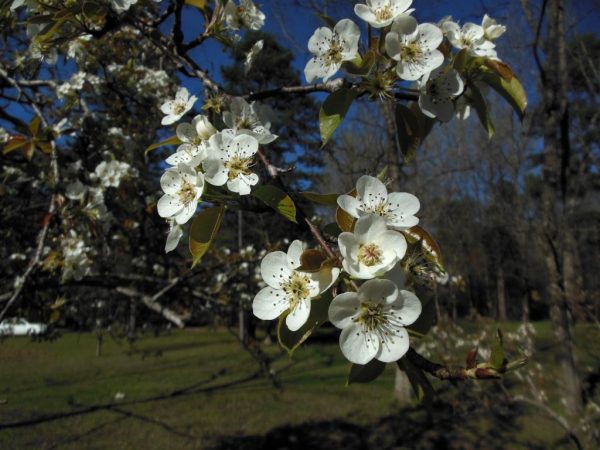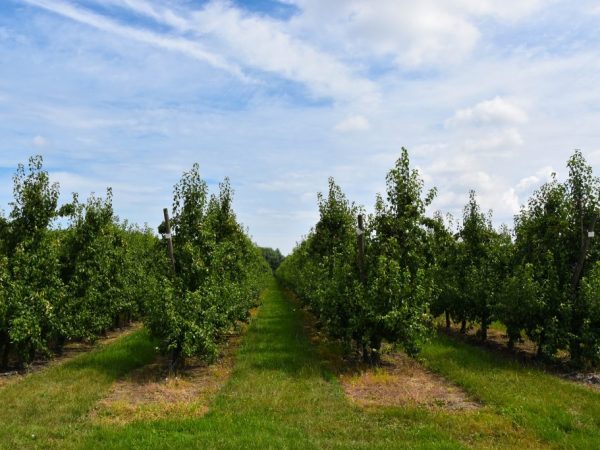How and what to feed a pear in spring
Feeding pears in spring is a very important process. Yield indicators will depend on the quality of its implementation. After all, the tree is thus prepared for the growing season. In order for fertilizers to be beneficial, it is necessary to correctly determine the timing of application, preparations and dosage. Otherwise, the plant can even be harmed.

Top dressing of pears in spring
When to feed
Pears love nutritious soil. Such a condition is not always met for growing crops. But even soils saturated with useful elements are depleted over time. Therefore, gardeners fertilize them regularly.
When landing
Initially, the soil is saturated with nutrients during planting - fertilizer is applied to the pit. Proper care includes feeding the pear in spring, summer and fall. The spring stage of this process is carried out with the aim of awakening the tree from hibernation.
The presence of nutrients in the soil contributes to the good development of vegetative organs - leaves and young shoots are formed, healthy ovaries are formed. The amount of fertilizer applied during this period should be 2/3 of the annual rate.
Late spring
At the end of spring, the remaining 1/3 of the minerals are added. Not all gardeners take part in this activity. It is believed that the funds contributed in the spring are enough for the fruits to be poured and ripen.
After harvest
Pre-winter feeding of pears begins at a time when the crop has already been harvested. Also, 3 parts of the leaves on the tree should turn yellow. Then the plant will perfectly tolerate the cold.
Features of spring feeding
For good growth of green mass, pear dressing in spring should be carried out taking into account the stages of tree development. Usually it is done in 3 stages:
- when the buds begin to swell and the temperature stabilizes, it contributes to the growth of a lush crown;
- during flowering - increases the number of inflorescences;
- after flowering - in order to improve the quality indicators of the harvest, the ovary is prevented from falling off.
Some gardeners apply fertilizers for the first time in early spring on a snow crust. It is believed that when the snow melts, nutrients will be absorbed into the ground. But it must be borne in mind that some mineral fertilizers have the property of losing some of the nutrients in the open air.
How to feed
You must be able to correctly calculate the dose of drugs. After all, excess has a bad effect on the pear. During the summer, she will continue to increase the green mass to the detriment of fruiting. Also, the wood will not harden. The fruits accumulate chemical elements that, if consumed, can be harmful to health. An excess of nitrogen in the soil threatens the pear with low winter hardiness and poor ripening of fruits.
Therefore, all funds must be paid strictly according to the instructions that are indicated for 1 sq. m. of land. It should be borne in mind that a tree aged 2-4 years has a root system of about 5 square meters. m., and at 6-8 years old - 10 sq. m.
In spring, root dressings are used in liquid or dry form.To know which one to choose, one must take into account the weather conditions. In rainy weather, nitrogen is scattered over the surface of the soil and dug up. Dry - diluted with water. Then they water the soil near the trunk or bring it into special grooves that make a circle of pears. The soil for these activities must be loose.
What to feed

Choose the right fertilizer
When choosing a fertilizer, it is worth considering the purpose for which it is applied. Therefore, it is necessary to feed the pear in the spring with nitrogen-containing substances. They are bought in the store in the form of granules or powder. Along with them, you can use fat containing phosphorus and potassium. They will help the ovaries not to crumble. All these funds tend to decompose for a long time, therefore, when introduced, they will acquire an assimilable form after a while.
Organic
Organic matter such as bird droppings is suitable as the first feeding. For watering one tree, its solution is used, which is prepared as follows: 10 liters of warm water are poured into 0.5 kg of droppings and insisted for a day.
Saltpeter
One of the widely used agents at this stage is ammonium nitrate. The solution is prepared in a ratio of 1:50. Consumption - no more than 30 g per 1 sq. m. It is necessary to apply in the near-trunk circle and only in moistened soil. Then they are additionally watered so that the roots receive nutrients.
Urea
Urea can be used during flowering. All contents are added to 5 liters of water. For introduction around the trunk, a groove is made, dispensing 80-120 g per crop. The exact consumption is determined taking into account the age of the tree and its dimensions.
Urea
Top dressing of pears in spring with urea has proven itself well. Spraying is carried out with a solution prepared on its basis. To do this, give 50 g of urea to a bucket of water. Processing is carried out 9-10 days after flowering.
Minerals
Also at the last stage, complex mineral products will be effective. As which you can take nitroammofosku. It is diluted with water in a ratio of 1: 200. The solution is applied under one tree in an amount of up to 30 liters. The use of this product cannot be combined with organic substances.
Green fertilizer
After flowering, you can still apply green fertilizer:
- weed - 2 buckets;
- water - 2 buckets;
- bird droppings - 2 kg.
Insist for about 7 days. Then 1 liter of concentrate is diluted in 1 bucket of water. Consumption - 25 liters per tree.
Some features
All solutions should be used immediately after preparation, but no more than 12 hours later. Instead of grooves, you can make 3-4 holes 20 cm deep. After adding the liquid, they are poured and tamped.
Top dressing in the spring for young pears (1 year old) should not be done. If the planting was carried out correctly, then the earth by this time still contains all the necessary substances.
If the spring is cold, then feeding is carried out by foliar method. Indeed, under difficult weather conditions, the roots do not absorb nutrients well. Then urea spraying can be applied.
Conclusion
It is necessary to feed pears in spring with fertilizers in a timely manner and correctly. After all, an overdose can cause plant burns, even its death. Proper care will ensure a good culture. This will bring the gardener a high yield in the future.

